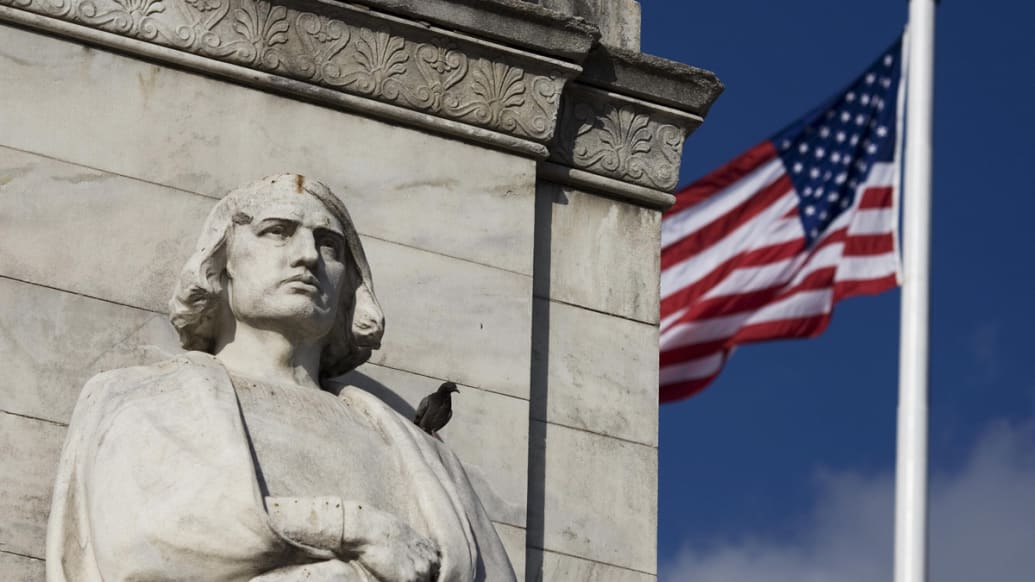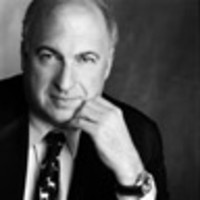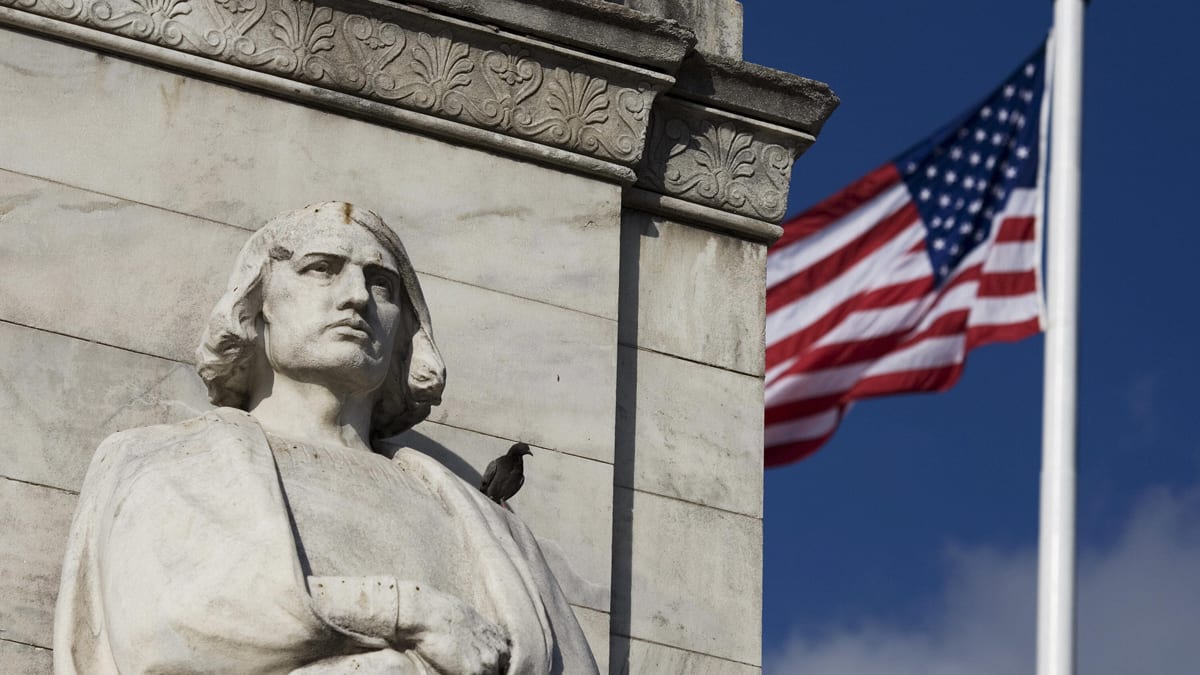Americans are forever seeking a fresh start, and exploration is our national habit. We take it as our birthright to stumble upon the unexpected, improvised yet somehow foreordained fulfillment of our hopes. In this respect Christopher Columbus lodges in everyone’s psyche. He sailed to white beaches in search of gleaming treasure, yet he was entirely mistaken about his whereabouts and sowed the seeds of centuries of strife, even though, in his own mind, he successfully completed his mission. He made four separate voyages to the Caribbean, and each time insisted he was on Asia’s doorstep. In his grandiose delusions Columbus seems to have established some of the fundamental parameters of who and what we wish to be as a nation and a people following a destiny from on high. And yet at times it seems we hardly know ourselves better than Columbus did at his lowest moments, even as we seek to emulate his uncanny luck, skill, and courage. He has become an important talisman either of something very good or very bad.
Capturing this deep ambivalence about Columbus, Mark Twain wrote in Pudd’nhead Wilson of Columbus Day, Oct. 12: “It was wonderful to find America, but it would have been more wonderful to miss it.”
All this was on my mind as I touched down at Las Américas International Airport in Santo Domingo in 2009, in the midst of researching a book about Columbus’s four voyages. I soon found myself in the city that he and his brother Bartholomew founded and, after it was moved and destroyed in a hurricane, refounded. It lays claim to be the oldest European settlement in the New World, established 1502, now a city of about 3 million and the capital of the Dominican Republic. Walking its streets at dusk—which I’d been cautioned not to do, unless accompanied—I quickly became aware of its essential kinship with the proud cities of Spain that had helped give rise to its existence, especially Seville, where many voyages of discovery, including those of Columbus, originated. It was as if I were walking through an unlikely amalgam of a European capital with New York City, which many Dominicans now call home. The air was alive with the spirit of the place, fragrant and humid, and humming with energy.
Santo Domingo is a city in which the distant past is always on display, and it was here that I went in search of Columbian artifacts and landscapes. At the site of his earliest settlement, La Isabela, skeletons of long-deceased Spaniards who traveled with him, their graves exposed, stare upward into eternity, the bones that were their arms crossed over their chests. The same flora and fauna that baffled Columbus still flourishes here, and the same beaches stretch invitingly into the warm azure water. Late one night in my austere hotel room, while leafing through the pages of a rare Spanish work of scholarship about Columbus’s voyages, I suddenly jumped back in horror, as the open pages revealed countless shiny white aphids feasting on the binding’s glue, and I recalled why Columbus’s men were reluctant to leave their ships and sleep on land, even in the hammocks they had copied from the Indians.
By contrast, I was staying in the generally comfortable Nicolas de Ovando hotel. A sturdy stone relic of the island’s colonial past, it is so named because it was originally the palace of the man charged with the task of replacing Columbus as governor of the island of Hispaniola. It was Ovando, I reflected, who let Columbus languish in a shipwreck on the coast of Jamaica for an entire year before dispatching a rescue ship too small to accommodate the survivors. That was just one of many callous attempts to thwart Columbus’s endeavors. He overcame that challenge and others presented by people and nature, succumbing finally to his own mortality.

The explorer left behind a world he never made and truly never imagined. If Columbus were to come back today and gaze up at the iconic statue of him by Gaetano Russo in New York’s Columbus Circle, he would be dumbfounded, both by the monument and by the urban frenzy surrounding it. The real Columbus, an ambitious and cunning Genoese mariner with a strong mystical inclination, was barely understood by his contemporaries, who were inclined to dismiss him or manipulate him. Even he was bewildered by the promptings of his faith and imagination.
Although Columbus Day, commemorating his first landfall in the New World, somewhere in the Bahamas—the precise location remains disputed—seems a quintessentially American holiday, it is a recent invention, established by FDR in 1937. And it has a fairly muddled heritage: Columbus, of course, believed throughout the course of his four voyages that he had not discovered a new world, but rather pioneered a water route to an old one, the India in he had read about in Marco Polo’s celebrated Travels. He was naively misguided about this to the end of his days. Furthermore, he never set foot in North America; he got no closer than a glimpse of the far-off Florida Keys before deciding to head south. Incredibly, he never guessed that North America existed, not even as an indistinct, monster-inhabited place on one of his fanciful maps.
Now, of course, his name and likeness are everywhere. Only Washington and Lincoln can vie with Columbus for the prevalence of their names on the nation’s map—and in the national consciousness. One would think that Columbus himself, his deeds, his persona, his biography, would all be intertwined with the history of these points of interest, the way George Washington and Abe Lincoln often are with landmarks named for them. Or that Columbus had at least anticipated that monuments would be erected in his memory and honor. But he no more knew of the places named for him than he did of the Pacific Ocean or of distant planets. He did not put these places on the map, he left them off the map—every single one of them. We are keenly aware of him; he was oblivious to the possibility of our existence.
Instead, during a sequence of four voyages, he meandered throughout the Caribbean, down the coast of Central America, exploring Trinidad, calling on Cuba, which he insisted was an extension of the Asian mainland, and trying to persuade others of his geographical folly. A master of twisting events to suit his purposes, he persuaded himself that he was getting closer to China all the time. On his first voyage, he even brought along a translator prepared to speak the ancient languages with the people he encountered. Instead, the inhabitants of Caribbean, known as the Taino, spoke in a mellifluous tongue replete with vowels and almost free of consonants: it was a dialect of Arawak, unknown to Europeans of that era. The linguistic barrier meant that Columbus and his crew often thought they knew what the “Indians”—that is, the Tainos—meant, when in fact they misinterpreted their gestures in interactions that had more in common with charades than with matters of exploration. Some discovery. Inspired by Marco Polo, Columbus expected to find some remnants of the long gone Mongol Empire, with its Grand Khan ready to do business with him, as he had with traders from Venice two centuries earlier. And, to make matters stranger still, Columbus on this third voyage believed he had discovered the entrance to Paradise, somewhere north of Venezuela. It was enough for him to locate it; he did not venture there.
Columbus was a vain, deluded, and Quixotic leader. And he was also a courageous and peerless navigator. He was not any one of these things; he was all of these things, many faceted and contradictory. The facts of his voyages to the New World are not in doubt—with the notable exception of the precise location of his first landfall—but interpretations grow more divergent all the time. For better or worse, or rather, for better and worse, he has left his improbable, indelible mark on the American spirit and on history.

